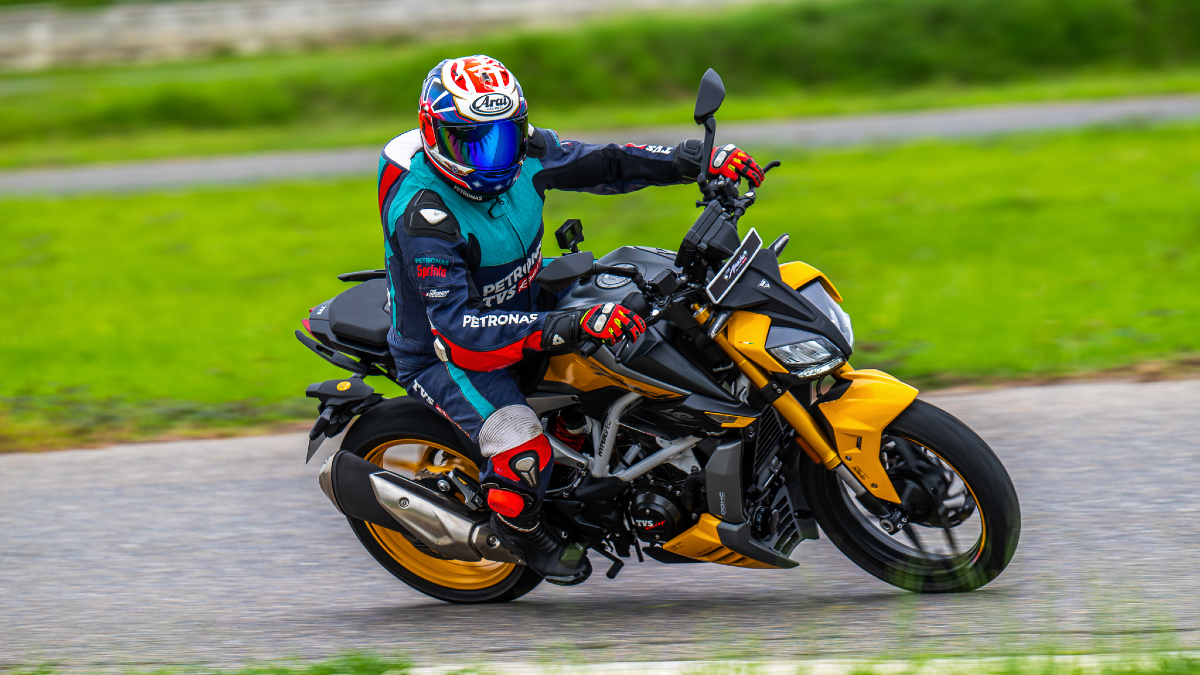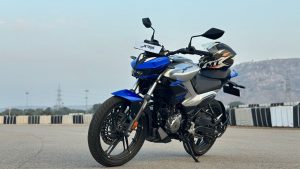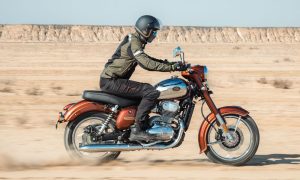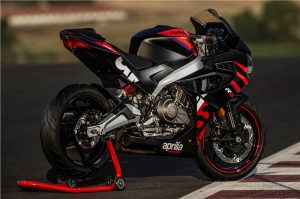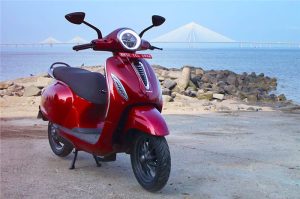With the addition of vehicles like the Triumph Speed 400 and Harley-Davidson X440 to the neo-retro ranks, the 300–400cc class has already had an incredibly interesting start to the year. It’s now the turn of even more advanced motorbikes. The brand-new KTM 390 Duke will soon be available, and TVS has unveiled the new Apache RTR 310 to get ready for the Austrian leader. This is essentially the Apache RR310 sportbike’s naked brother, but TVS has done much more than simply swap out the handlebar and remove the fairing.
Design of TVS Apache RTR 310
The design is undoubtedly one major area that has changed. Your posture is hunched over and your lines are crisp and tidy, giving you a highly attractive streetfighter appearance. The handlebar is broad and tall, the tank extensions are exactly the right size, and the LED headlight is positioned low on the golden upside-down fork. The bike has a bulky front end, which is accentuated by the huge headlight pod. The back end of the bike is quite tidy because the number plate and indicators are located on the rear tyre hugger. As cool as this design is, it has a striking similarity to the Ducati Streetfighter V4 in terms of overall profile and posture. In fact, details like the radiator shrouds and lower cowl have a striking likeness.
Features of TVS Apache RTR 310
TVS has definitely followed its own route in the features department, incorporating cutting-edge technology and a great deal of creativity in this motorbike. Not only do the seemingly very brilliant dual LED headlights switch on and off automatically, but they also alter their brightness in two phases based on the bike’s speed. During our time on the bike, we had the opportunity to experience it equipped with the BTO customisation packs that TVS is providing for the RTR. These packs come with a variety of IMU-assisted rider aids, including as cornering ABS, cornering traction control, and intersection cruise control. There’s also a bi-directional quickshifter, and all of this is managed by a brand-new 5-inch TFT screen that connects to your phone, GoPro, and helmet communicator via Bluetooth.
The quickshifter is standard on all variants save the base model, and you still get basic traction control, cruise control, and ABS even without the BTO kits. This motorbike is the first in the world to have a seat with a cooling function thanks to the climatic control seat, which is a unique and really amazing feature. It is included in the Dynamic Pro kit together with the IMU-assisted assistance. We discovered that this seat is fairly effective; the temperature variation is most noticeable when it is first activated. It works fine, but after a while you become used to it and it fades to the background of your thoughts. You should be aware, though, that sitting on the hard Peltier element—which causes the temperature change—if you are a shorter rider or prefer to lean on the fuel tank can result in some unpleasant back pain.
Despite this, the 2017 RTR’s sitting comfort is excellent. The footpegs are positioned in a sporty yet comfortable manner, and the lean towards the handlebars is just enough to feel connected and involved without ever being uncomfortable. Although not the most capacious seat available, it is rather large, and if you sit all the way back, the firm backrest at the front of the pillion perch may become uncomfortable. This is especially true when you’re completely focused and on track.
The riding and handling of the TVS Apache RTR 310
We had the opportunity to test the RTR 310 on adjustable suspension on both ends since the Dynamic package (which also includes a TPMS and a brass-coated chain) was installed on our bike. We won’t judge Thailand’s roads—which are generally of very high quality—until later. The ride seemed a touch fidgety and active over an uneven concrete road, but overall, the bike handled the little rough stuff we managed to put it over very well, maintaining calm but also displaying a hint of underlying toughness. The completely adjustable fork and the monoshock’s tunable preload and rebound damping offer plenty of adjustment, so you should be able to find a setup that suits your needs.
This new RTR handles like TVS, which stands for light, natural, predictable, and easy. It’s a fantastic road sport bike that will be happy to take on some twisties on the weekends. We also got to test it out on the track, and although it was still a quite enjoyable machine there, this is not the kind of bike that takes well to severe pushing. Although the Michelin Road 5 tyres are quite grippy, you will eventually run out of space when cornering, and larger riders will also find it difficult to find room when they start to scramble around on the bike.
Even in Track mode, we found traction control to be quite cautious and obtrusive, so experienced riders are best off keeping it off while racing. However, it functions incredibly well when driving, stepping in discreetly when needed and never coming off as intrusive. It always operated well and never cut power, even on loose gravel terrain. On the road, cruise control performed as promised; however, because it depends on the radius of the turn and your speed, the cornering feature, which lowers your speed as you lean into it, is not very useful.
Engine TVS Apache RTR 310
With regard to this motorcycle’s chassis and characteristics, there is hardly anything to complain about. However, its core is the same 312cc, single-cylinder, liquid-cooled engine found in the Apache RR310, which has advantages and disadvantages. while TVS’s persistent attempts over the years to address this, this engine has developed a reputation for being a fairly buzzy and vibey unit while being lively and adaptable. Unfortunately, the buzzy aspect of the new RTR is still present, and it’s made worse by TVS’s drastic reduction of the gearing (4 teeth up on the rear sprocket) in comparison to the RR. The biggest vibrations occur between 5,000 and 7,000 rpm, and on particular RTR, that starts at around 85 kph in sixth gear. There is a lot of buzzing in the handlebar, seat, and footpegs, and the engine seems like it is revving rather high during a 100 kph drive.
The high end of the motor is pretty delightful since it smooths out considerably beyond 8,000 rpm and pulls fairly beautifully at 10,000 rpm. In fact, there are actually fewer vibrations at 135 kph than there are at 100 kph. However, engine refinement is a problem in the rev ranges and speeds where you will be using it most of the time. In addition, there was a slight lag between closing the throttle and cutting the power, which was a problem we had with the trailing throttle. On two of the bikes we rode, this occurred to differing degrees. It was more noticeable in the urban and rain modes, when the engine is set to a lower power setting. Additionally, there was a little issue whereby the quickshifters on both bikes would occasionally switch off by themselves when the keys were turned on and off. It functioned well when it was turned on, providing fluid shifts even at low RPMs and with partial throttle. When pushed hard, it also performed well when it was on course.
Regarding performance, the motor has an excellent power distribution, being tractable at low speeds, developing into a pleasant mid-range, and maintaining strong pulling power throughout. Due to TVS’s modifications to the mapping, intake, and exhaust, the vehicle feels lighter in the city and has somewhat more power and torque. In addition, the exhaust sound from the latter is better, less thrashy, and deeper than that of the RR310. Usually Apache brakes have a little bite at first, but after you pull the lever correctly, they have more than enough stopping strength.
Pricing of TVS Apache RTR 310
You may purchase the Apache RTR 310 in a variety of ways, and each one comes with a somewhat different motorbike. The TFT screen, dynamic LED headlights, non-cornering ABS, traction control, cruise control, and other features are all included in the basic model, which costs Rs 2.43 lakh and does not include a quickshifter. The quickshifter adds Rs 15,000 to the price, bringing it to Rs 2.58 lakh; the yellow colour scheme shown above raises the price to Rs 2.64 lakh. Then, to access the really luxurious amenities, you’ll need to pay Rs 18,000 for the Dynamic kit, which includes an adjustable suspension, TPMS, and a brass-coated chain, and Rs 22,000 for the Dynamic Pro kit, which includes an IMU-assisted rider assistance and a climate control seat. At this point, your total expenditure would have surpassed Rs 3 lakh. This means that an RTR 310 with all the bells and whistles costs more than the current KTM 390 Duke. When you add the Sepang Blue colour scheme, the price goes up an additional Rs 10,000.
The RTR 310 is a decent value bundle when it comes to its lower end of the pricing range. It costs Rs 10,000 more than the Triumph Speed 400, but the upgrade gives you a motorcycle with more features and advanced technology. Despite having all the necessary components, the Apache is competing in a totally different market. The 390 Duke is a highly good motorbike, and the next model is expected to surpass it.
verdict for TVS Apache RTR 310
TVS is introducing a less specialised, more adaptable option on its 310cc platform with the Apache RTR 310. It retains many of the qualities we appreciate about the RR310 while adding a tonne of new functionality. However, it also has many of the same problems. After seven years, it seems like TVS and BMW should get rid of this powertrain because the competition is outperforming it in terms of both power and refinement.
This bike has drawbacks if you were hoping to use it as your future long-distance, all-around vehicle. However, the RTR can provide you with a stylish, thrilling, feature-rich city bike that is equally enjoyable on a twisting road, along with some exclusive extras and bragging rights. It will be intriguing to watch if TVS can ultimately stave off that impending Austrian charge.

